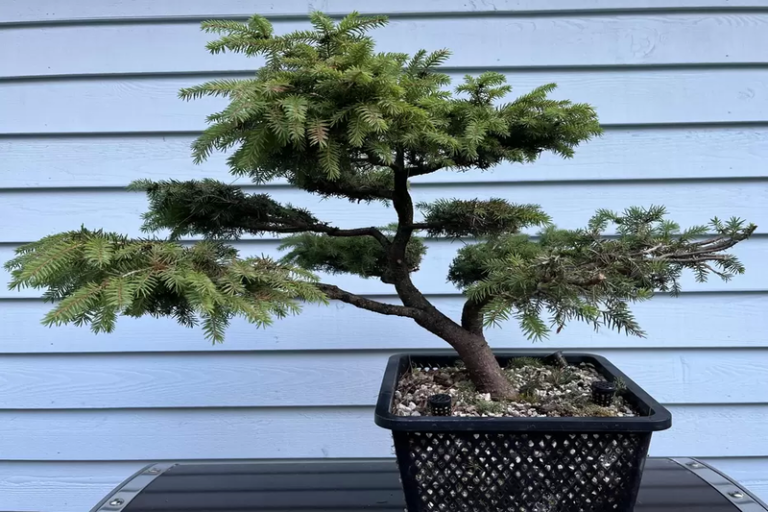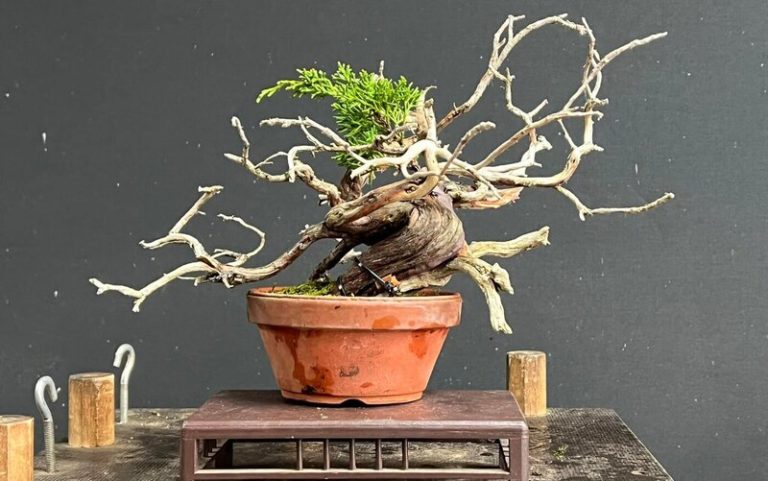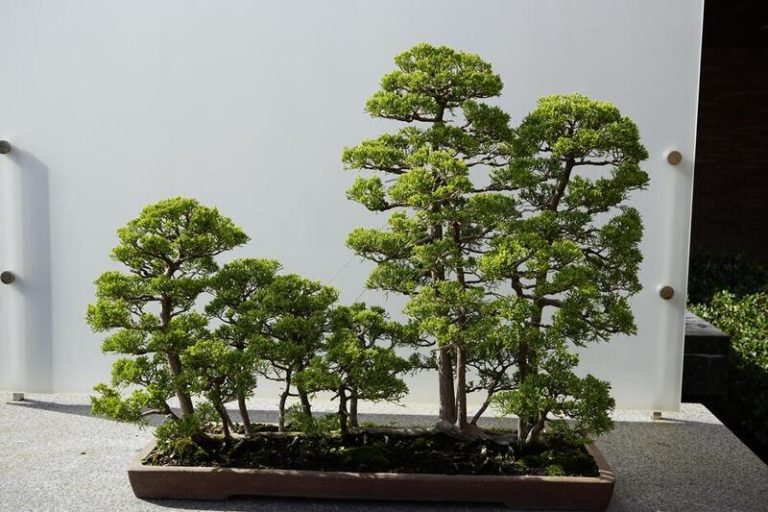Solanum Bonsai: Unlocking the Art of Miniaturizing Nature
Solanum Bonsai is a small tree that has become famous among people who grow bonsai. The Solanum plant family is where this tree comes from. It has unique qualities and can be a satisfying experience for both new and experienced bonsai fans.
What is a Solanum Bonsai?
Solanum Bonsai is a small bonsai tree that belongs to the Solanum plant family. It is a miniature version of the Solanum plant, with delicate leaves, beautiful flowers, and tiny fruits. It grows to a height of around 8 to 12 inches and is cultivated and trained as a bonsai tree for its unique and artistic form. Suitable growing conditions, including moderate temperatures, sunlight with partial shade, and well-draining soil, are necessary for its healthy growth. Solanum Bonsai can be styled in various bonsai techniques and offers bonsai enthusiasts a rewarding and enjoyable experience.
History and Origins of the Solanum Bonsai
The history and origins of the Solanum Bonsai can be traced back to the art of bonsai itself, which originated in ancient China and later spread to Japan. Bonsai is the practice of cultivating and shaping miniature trees in containers, creating living works of art.
The Solanum Bonsai is a blooming plant that belongs to the Solanum plant family. The precise origin of Solanum Bonsai as a bonsai cultivar is unknown. However, it is thought that the skill of bonsai care and experimenting with other plant species resulted in the emergence of Solanum Bonsai as a separate bonsai tree.
Bonsai enthusiasts and horticulturists have studied several plant species and their appropriateness for bonsai growth throughout the years. As part of this investigation, the Solanum plant was chosen and trained to generate tiny versions known as Solanum Bonsai, with its gorgeous leaves, flowers, and fruits.
The art of bonsai has spread widely, and several bonsai kinds, notably Solanum Bonsai, have acquired appeal among bonsai aficionados worldwide. Solanum Bonsai has become a sought-after bonsai variety because to meticulous cultivation, pruning, and shaping procedures. It is regarded for its beauty, compact size, and aesthetic appeal.
While the specific history and origins of Solanum Bonsai may not be well-documented, its existence and popularity within the bonsai community highlight the ongoing evolution and experimentation in the art of bonsai cultivation.
Solanum Bonsai and Their Symbolism
Solanum Bonsai, like many other bonsai varieties, carries symbolic meanings and cultural significance. While the specific symbolism can vary across cultures and individuals, here are some general symbolic associations often attributed to Solanum Bonsai:
1. Beauty and Harmony: Solanum Bonsai, with its delicate foliage, charming flowers, and miniature fruits, represents the beauty and harmony found in nature. The carefully shaped and styled bonsai tree embodies a sense of balance and aesthetics, evoking a serene and peaceful ambiance.
2. Perseverance and Endurance: Bonsai cultivation requires patience, dedication, and long-term commitment. The slow growth of Solanum Bonsai reflects the virtues of perseverance and endurance. The ability of Solanum Bonsai to withstand different growing conditions and adapt to the bonsai training process symbolizes resilience and strength.
3. Balance between Nature and Human Intervention: Bonsai, including Solanum Bonsai, embodies the harmonious coexistence of nature and human intervention. By shaping and training the bonsai tree, humans demonstrate their appreciation and respect for the beauty of nature. Solanum Bonsai represents the delicate balance between the control exerted by bonsai artists and the innate beauty of the natural world.
4. Reflection of the Macrocosm in the Microcosm: Bonsai is frequently regarded as a small depiction of the natural world. The exquisite intricacies and scaled-down size of Solanum Bonsai represent the greater ecosystem and the majesty of nature in a tiny and manageable environment. It acts as a reminder of the natural world’s interconnectivity and immensity.
5. Serenity and Contemplation: The art of bonsai fosters a quiet and meditative attitude. When exhibited and respected, Solanum Bonsai can create feelings of calm and tranquillity. It serves as a focus for reflection, awareness, and appreciating the present moment.
It should be noted that these symbolic readings may differ based on cultural viewpoints, personal beliefs, and individual experiences. Bonsai symbolism is frequently subjective and susceptible to personal interpretation, allowing each observer to discover their own meaning and connection to Solanum Bonsai and the art of bonsai in general.
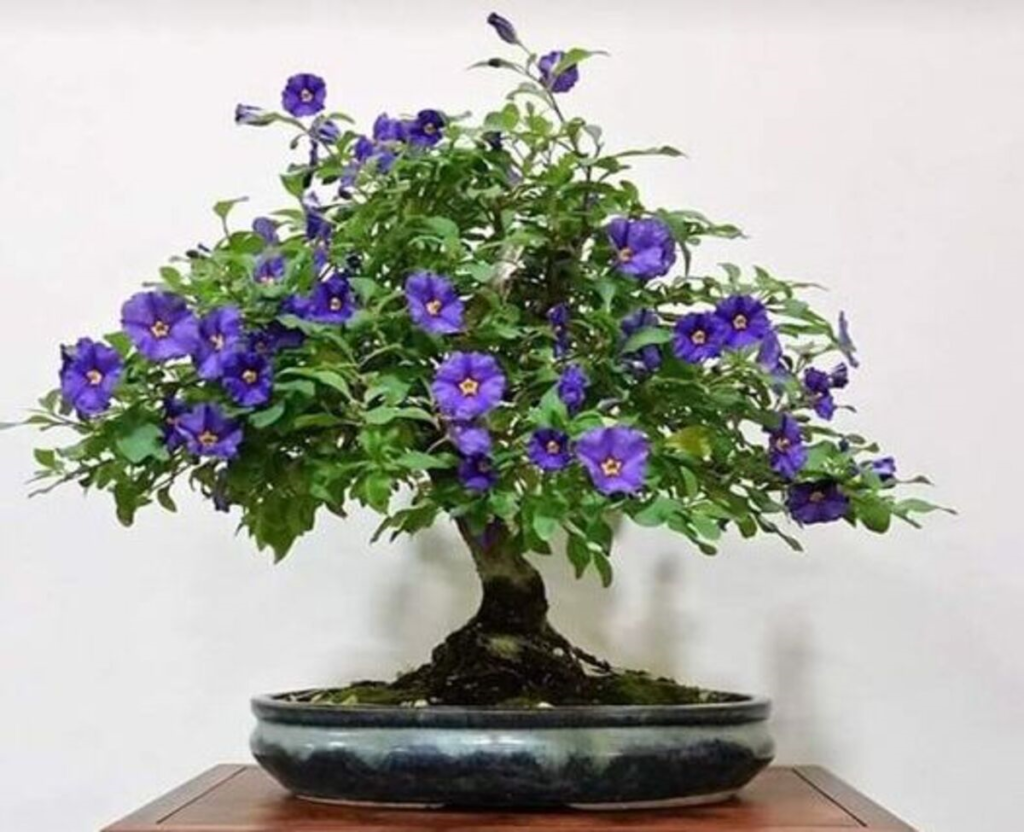
Characteristics of the Solanum Bonsai
Solanum Bonsai, also known as the Solanum plant in its miniature form, exhibits several distinct characteristics that make it a desirable choice for bonsai enthusiasts. Here are some key characteristics of Solanum Bonsai:
- Size: Solanum Bonsai is a small-sized bonsai tree, typically reaching a height of about 8 to 12 inches (20 to 30 centimeters). Its compact size makes it suitable for small spaces, indoor cultivation, and tabletop displays.
- Foliage: The foliage of Solanum Bonsai consists of delicate, small-sized leaves. These leaves are often ovate or lobed in shape, depending on the specific species or cultivar. The leaves may have a glossy or matte texture, adding to the visual appeal of the bonsai.
- Flowers: The flowers of Solanum Bonsai make the tree look pretty and bright. The flowers can be white, yellow, purple, or blue, based on the type. The flowers are usually small, but they can grow in groups to make a pretty sight.
- Fruits: Another distinctive characteristic of Solanum Bonsai is the production of miniature fruits. These fruits are typically small and may resemble tiny berries. The color of the fruits can range from green to yellow or even red, depending on the specific species. While the fruits are small, they contribute to the overall aesthetic appeal of the bonsai tree.
- Branching and Bark: Solanum Bonsai develops a well-branched structure, with branches that can be shaped and trained according to the desired bonsai style. The bark of the tree can vary in texture, ranging from smooth to slightly rough or fissured, depending on the age and species of the bonsai.
- Adaptability: Solanum bonsai has a certain amount of adaptability that lets it grow in a wide range of circumstances. It can do well both indoors and outdoors, based on the species and the temperature. But in general, it likes mild temperatures and enough sunshine with some shade.
These characteristics make Solanum Bonsai an appealing choice for bonsai enthusiasts who appreciate its compact size, beautiful foliage, charming flowers, and miniature fruits. Its adaptability and ease of cultivation add to its overall appeal as a bonsai tree.
Types of Solanum Bonsai
There are several species and cultivars of Solanum that can be trained and cultivated as bonsai. Here are some notable types of Solanum Bonsai:
Solanum rantonnetii: Also known as Blue Potato Bush or Lycianthes rantonnetii, this species features vibrant blue or purple flowers and dark green foliage. It is a popular choice for bonsai due to its attractive blooms and relatively compact growth habit.
Solanum melongena: Commonly known as Eggplant or Aubergine, Solanum melongena can be trained as a bonsai tree. It has distinctive large leaves and can produce small purple or white flowers. The bonsai version of this plant showcases the unique form and character of the eggplant in a miniature size.
Solanum lycopersicum: Solanum lycopersicum, commonly known as Tomato, can also be cultivated as a bonsai. The miniature tomato plant displays small-sized fruits in various colors, including red, yellow, or even striped varieties. Growing a tomato bonsai can be a fun and unique experience.
Solanum pseudocapsicum: Also called Jerusalem Cherry, Solanum pseudocapsicum is a popular choice for bonsai due to its ornamental berries. The small red or orange fruits resemble cherries and add a pop of color to the bonsai tree.
Solanum nigrum: Solanum nigrum, commonly known as Black Nightshade, is another species that can be trained as a bonsai. It features small white flowers and black berries. The compact growth habit of this plant lends itself well to bonsai cultivation.
These are only a handful of the Solanum species that may be cultivated into bonsai trees. various species have various growth tendencies, leaf forms, flower colors, and fruit sizes, allowing bonsai lovers to explore and experiment with different varieties of Solanum Bonsai to produce distinctive and visually stunning miniature trees.
How to Grow a Solanum Bonsai
To promote a healthy development of a Solanum Bonsai, some critical criteria must be considered. Here’s how to cultivate a Solanum Bonsai step by step:
1. Select a Suitable Solanum Species: Choose a Solanum species that is suitable for bonsai cultivation, such as Solanum rantonnetii (Blue Potato Bush) or Solanum melongena (Eggplant). Consider factors such as climate, available space, and personal preferences.
2. Choose the Right Container: Choose a shallow bonsai container with drainage holes to let excess water to drain. The container should be appropriate to the size of the bonsai tree.
3. Provide Well-Draining Soil: Use a well-draining soil mix specifically designed for bonsai cultivation. It should have good water retention while allowing excess water to drain away. Avoid using regular garden soil, as it may not provide the required drainage.
4. Place in Optimal Lighting Conditions: Solanum Bonsai enjoys a sunny site with some shade. Place the bonsai in a bright window or a well-lit site outside. Consider the light needs of the chosen Solanum species.
5. Watering: Water the Solanum Bonsai when the topsoil feels slightly dry to the touch. Avoid overwatering, as it can lead to root rot. Ensure that water drains out of the drainage holes, and never let the bonsai sit in a water-filled tray.
6. Fertilization: Apply a balanced liquid or granular fertilizer formulated for bonsai once every few weeks during the growing season (spring and summer). Follow the instructions on the fertilizer package for the appropriate dilution and frequency.
7. Pruning and Shaping: Regular pruning is essential to maintain the desired shape and size of the Solanum Bonsai. Remove any overgrown branches or leaves to promote a compact and balanced appearance. You can use pruning shears or bonsai-specific tools for precise cuts.
8. Wiring and Training: If needed, use bonsai wire to gently shape and guide the branches of the Solanum Bonsai. Take care not to apply excessive pressure that may damage or injure the tree. Regularly check the wiring to ensure it does not cut into the bark.
9. Repotting: Every 2-3 years, repot the Solanum Bonsai, usually in the early spring before new growth begins. Remove the bonsai from its present container with care, cut the roots, and transplant it in new bonsai soil. During repotting, prune the branches as needed.
10. Pest and Disease Control: Monitor the Solanum Bonsai regularly for any signs of pests, such as aphids or spider mites. If necessary, use appropriate organic or chemical treatments to control pests. Maintain good airflow and avoid overwatering to prevent fungal diseases.
By following these steps and providing proper care, your Solanum Bonsai can thrive and develop into a beautiful and healthy miniature tree. Regular observation and adjustment of care practices based on the specific needs of the chosen Solanum species will contribute to its successful growth as a bonsai.
Benefits of the Solanum Bonsai
Like other bonsai plants, Solanum Bonsai provides various advantages that make it a popular option among bonsai lovers. Here are some advantages of growing a Solanum Bonsai:
- Aesthetic Appeal: Solanum Bonsai displays a captivating aesthetic appeal with its compact size, delicate foliage, colorful flowers, and miniature fruits. Its artistic form and unique characteristics make it a visually pleasing addition to any indoor or outdoor space.
- Stress Relief and Relaxation: Bonsai cultivation, including Solanum Bonsai, has a therapeutic effect and can help reduce stress. Engaging in the process of caring for and shaping the bonsai tree promotes mindfulness and relaxation, providing a calming experience.
- Connection with Nature: Growing a Solanum Bonsai allows individuals to connect with nature in a meaningful way. The intimate care and observation required for the bonsai’s well-being deepen one’s appreciation for the natural world and foster a sense of responsibility towards living organisms.
- Space Efficiency: Solanum Bonsai’s small size makes it well-suited for those with limited space. Whether you live in an apartment, have a small garden, or wish to keep a bonsai indoors, Solanum Bonsai can be cultivated in compact containers, bringing the beauty of nature to small spaces.
- Creativity and Artistic Expression: Cultivating Solanum Bonsai provides an opportunity for artistic expression. Through pruning, shaping, and training techniques, bonsai enthusiasts can create unique designs, expressing their creativity and personal style.
- Educational Value: Growing a Solanum Bonsai offers a valuable learning experience. It provides insights into horticulture, plant biology, and the delicate balance of nurturing a living organism. Bonsai cultivation encourages patience, observation, and the development of gardening skills.
- Longevity: With proper care and attention, Solanum Bonsai can live for many years, even decades. This long lifespan allows bonsai enthusiasts to develop a deep bond with their trees, witnessing their growth and transformation over time.
- Conversation Starter: Solanum Bonsai serves as a unique and intriguing conversation piece. Its miniature size and artistic form attract attention and can spark conversations about the art of bonsai, gardening, and the beauty of nature.
- Bonsai Community and Networking: Cultivating Solanum Bonsai can connect you with a vibrant community of bonsai enthusiasts. Participating in bonsai exhibitions, workshops, and online forums allows you to share knowledge, exchange ideas, and build connections with fellow enthusiasts.
- Legacy and Tradition: Bonsai has a rich cultural and historical significance, originating in ancient China and flourishing in Japan. By growing Solanum Bonsai, you become part of a longstanding tradition, preserving and passing on the art of bonsai to future generations.
These benefits make cultivating a Solanum Bonsai a rewarding and enriching experience, offering not only aesthetic enjoyment but also opportunities for personal growth, creativity, and a deeper connection with nature.
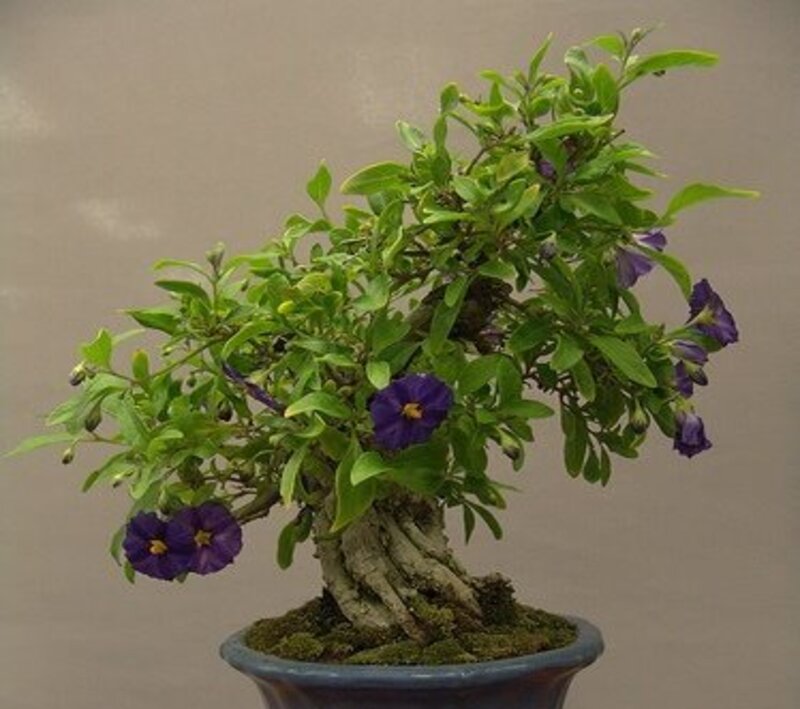
Displaying Solanum Bonsai
Displaying a Solanum Bonsai is an essential aspect of appreciating its beauty and creating an appealing visual impact. Here are some tips on how to effectively display your Solanum Bonsai:
Choice of Display Stand: Select an appropriate display stand or bonsai pot for your Solanum Bonsai. Consider the size, style, and color of the stand or pot to complement the tree’s aesthetics. A wooden or ceramic stand can provide a natural and harmonious backdrop for the bonsai.
Placement: Choose a location that provides suitable lighting conditions for your Solanum Bonsai. Most Solanum species thrive in bright, indirect light. Place the bonsai near a window or in a well-lit area of your home or garden, ensuring it receives adequate sunlight while avoiding direct exposure to intense midday sun.
Consider the Viewing Angle: Determine the optimal viewing angle for your Solanum Bonsai. Bonsai trees are traditionally displayed at a slightly elevated position to showcase their beauty and intricate details. Placing the bonsai on a higher surface, such as a table or stand, allows viewers to appreciate the tree’s overall shape and foliage more effectively.
Background and Complementary Elements: Create a visually appealing backdrop for your Solanum Bonsai by choosing an appropriate background. A plain wall or a neutral-colored screen can help draw attention to the bonsai. Additionally, consider adding complementary elements, such as small accent plants, decorative stones, or bonsai figurines, to enhance the overall display and create a harmonious composition.
Balance and Composition: Achieve a sense of balance and visual harmony by positioning your Solanum Bonsai within the display area. Consider the placement of branches, foliage density, and the overall silhouette of the tree. Avoid overcrowding the display with too many elements, allowing the bonsai to be the focal point.
Rotating the Bonsai: Regularly rotate your Solanum Bonsai to ensure even growth and prevent the tree from leaning toward the light source. Rotating the bonsai every few weeks helps promote balanced development and maintains its overall symmetry.
Seasonal Display: Embrace the changing seasons by adapting your Solanum Bonsai display accordingly. Some Solanum species may produce flowers or fruits during specific times of the year. Highlight these seasonal features by placing the bonsai in prominent locations or incorporating complementary decorations that reflect the season.
Maintenance and Grooming: Keep your Solanum Bonsai well-maintained and groomed to preserve its visual appeal. Regularly remove any dead or unhealthy foliage, prune branches for shape and balance, and ensure the bonsai is free from pests or diseases. A well-groomed bonsai enhances its overall display and aesthetic impact.
Remember, the display of your Solanum Bonsai is an opportunity for personal creativity and expression. Experiment with different arrangements, backgrounds, and elements to find the display style that best showcases the unique beauty of your bonsai tree.
Styling and Design of a Solanum Bonsai
The styling and design of a Solanum Bonsai involve shaping and training techniques to create a visually appealing tree with a distinct character. Here are some considerations and techniques for styling and designing your Solanum Bonsai:
1. Selecting a Style: Determine the bonsai style that best suits your Solanum Bonsai. Common styles include formal upright (Chokkan), informal upright (Moyogi), slanting (Shakan), cascade (Kengai), and semi-cascade (Han-Kengai). Choose a style that complements the natural growth pattern and characteristics of your Solanum species.
2. Trunk and Branch Placement: Evaluate the trunk line and branch structure of your Solanum Bonsai. The trunk should have a gradual taper, thicker at the base and gradually thinning toward the apex. Position the primary branches in a balanced and aesthetically pleasing manner, creating a harmonious overall silhouette.
3. Wiring: Use bonsai wire to gently shape and guide the branches of your Solanum Bonsai. Wiring allows you to create desirable bends and curves, giving the tree an artistic and structured appearance. Be cautious not to apply excessive pressure that may damage or break the branches. Regularly check the wire to ensure it does not cut into the bark, and remove it once the branches have set in their desired position.
4. Pruning: Regular pruning is crucial for maintaining the shape and size of your Solanum Bonsai. Use sharp bonsai pruning shears to remove excess growth, especially on branches that disrupt the overall design or deviate from the desired shape. Pruning also encourages back-budding, which leads to the development of more compact foliage.
5. Leaf Reduction: To achieve a more refined and compact appearance, consider leaf reduction techniques. Pinch or trim the leaves of your Solanum Bonsai to encourage the growth of smaller-sized leaves. This technique enhances the sense of proportion and creates a more harmonious balance between the branches and foliage.
6. Deadwood Techniques: Some Solanum species may develop deadwood features over time, such as naturally aged or weathered-looking areas on the trunk or branches. You can enhance the tree’s visual interest by applying deadwood techniques, such as carving, hollowing, or creating shari (stripped bark) and jin (deadwood branches). These techniques add character and a sense of age to your Solanum Bonsai.
7. Consideration of Species-Specific Traits: Different Solanum species have unique growth habits and characteristics. Consider these traits when styling and designing your Solanum Bonsai. For example, if your Solanum species naturally produces clusters of flowers or fruits, highlight these features in the design to showcase their beauty.
8. Balance and Harmony: Strive for balance and harmony in the overall design of your Solanum Bonsai. Maintain a sense of proportion between the trunk, branches, foliage, and any additional features, such as deadwood or accent plants. Avoid overcrowding or excessive branching, as it can distract from the tree’s natural elegance.
Remember that styling and designing a Solanum Bonsai is a gradual and ongoing process. It requires patience, observation, and regular maintenance to develop a well-balanced and visually appealing tree. Adapt your techniques and approach based on the specific characteristics and growth patterns of your Solanum species, ensuring that the design enhances the tree’s natural beauty.
How to Care for and Maintain a Solanum Bonsai
Caring for and maintaining a Solanum Bonsai is essential to ensure its health, growth, and longevity. Here are some key aspects to consider when caring for your Solanum Bonsai:
- Sunlight: Solanum Bonsai thrives in bright, indirect sunlight. Place your bonsai in a location where it receives at least 4-6 hours of sunlight per day. Adjust the placement based on the specific light requirements of your Solanum species. If necessary, supplement natural light with artificial grow lights.
- Watering: Proper watering is crucial for the health of your Solanum Bonsai. Water the bonsai when the topsoil feels slightly dry to the touch. Avoid overwatering, as it can lead to root rot. Ensure that water drains freely from the drainage holes to prevent waterlogging. Adjust the frequency of watering based on environmental factors such as temperature and humidity.
- Soil: Use a well-draining bonsai soil mix specifically formulated for your Solanum Bonsai. Avoid using regular garden soil, as it may not provide adequate drainage. The soil mix should retain moisture while allowing excess water to drain away. Repot your Solanum Bonsai every 2-3 years to refresh the soil and prevent root-bound conditions.
- Fertilization: Feed your Solanum Bonsai with a balanced, slow-release bonsai fertilizer or a liquid fertilizer formulated for bonsai trees. Follow the instructions on the fertilizer package for the appropriate dilution and application frequency. Fertilize during the growing season (spring and summer) to support healthy growth and development.
- Pruning and Training: Regular pruning is necessary to maintain the shape and form of your Solanum Bonsai. Remove any dead, damaged, or overgrown branches to promote a balanced and compact appearance. Use bonsai pruning shears or sharp scissors for precise cuts. Additionally, train and shape the branches using bonsai wire to create the desired form.
- Pest and Disease Control: Monitor your Solanum Bonsai regularly for signs of pests, such as aphids, spider mites, or scale insects. If you notice any infestation, treat it promptly with appropriate organic or chemical pesticides. Maintain good airflow around the bonsai and avoid overwatering to prevent fungal diseases. Remove any diseased or yellowing foliage to prevent the spread of infection.
- Winter Care: Solanum Bonsai may require special care during the winter months, depending on the specific species and your climate. Some Solanum species are frost-sensitive and need protection from freezing temperatures. Consider moving your bonsai indoors or providing frost protection, such as wrapping the pot with insulating material or placing it in a sheltered location.
- Regular Maintenance: Regularly inspect your Solanum Bonsai for any signs of stress, disease, or nutrient deficiencies. Keep the bonsai clean by removing fallen leaves or debris from the pot. Maintain the overall aesthetics by trimming and shaping the tree as necessary.
- Observation and Adjustment: Pay close attention to the specific needs of your Solanum Bonsai. Observe how it responds to different care practices and adjust your watering, fertilization, and maintenance routines accordingly. Each bonsai is unique, and understanding the individual requirements of your Solanum species will contribute to its overall well-being.
You may have a healthy and growing Solanum Bonsai that will provide beauty and delight to your environment for years to come by providing adequate care, attention, and maintenance. Regular maintenance and monitoring will allow you to form a deep relationship with your bonsai tree and ensure its health and vitality.
Solanum Bonsai Care Sheet
| Aspect | Care Tips |
| Watering | Water when the topsoil feels slightly dry to the touch. Avoid overwatering to prevent root rot. |
| Sunlight | Place in bright, indirect sunlight for 4-6 hours daily. Adjust based on species’ light requirements. |
| Temperature | Maintain temperatures between 60-80°F (15-27°C). Protect from extreme heat or cold. |
| Humidity | Moderate to high humidity is ideal for Solanum Bonsai. Mist the foliage regularly if needed. |
| Fertilization | Use a balanced, slow-release bonsai fertilizer. Follow package instructions for frequency and dosage. |
| Pruning and Trimming | Regularly prune to maintain shape and remove dead/damaged branches. Trim foliage for density control. |
| Wiring and Styling | Use bonsai wire to shape branches and create desired form. Be careful not to damage the branches. |
| Repotting | Repot every 2-3 years using a well-draining bonsai soil mix. Refresh the soil to prevent root-bound conditions. |
| Pest and Disease Control | Monitor for pests and treat promptly with appropriate pesticides. Remove diseased foliage to prevent spread. |
| Winter Care | Provide protection from freezing temperatures if necessary. Consider moving indoors or using insulation. |
| Regular Maintenance | Regularly inspect for stress, disease, or nutrient deficiencies. Keep the bonsai clean and groomed. |
Remember to adjust the care routine based on the specific needs and characteristics of your Solanum Bonsai species. Regular observation and adaptation will help ensure the health and vitality of your bonsai tree.
Conclusion
Solanum Bonsai offers a delightful and rewarding experience for bonsai enthusiasts. With proper care, this miniature tree can flourish and bring natural beauty to any space. Remember to provide the right growing conditions, practice regular maintenance
FAQ:
Q: What is a Solanum Bonsai?
A: A Solanum Bonsai is a miniature tree created from a species belonging to the Solanum genus, which includes plants like tomatoes and eggplants. Solanum Bonsai is cultivated using bonsai techniques to create a small, aesthetically pleasing tree in a bonsai pot.
Q: How small do Solanum Bonsai trees grow?
A:The size of Solanum Bonsai trees varies according on species and amount of trimming and training. They can range in size from a few inches to many feet.
Q: Can I keep a Solanum Bonsai indoors?
A: Yes, Solanum Bonsai can be kept indoors, but they require proper care and attention. Ensure they receive sufficient sunlight, appropriate watering, and adequate humidity to thrive indoors.
Q: How often should I water my Solanum Bonsai?
A: When the dirt on your Solanum Bonsai seems somewhat dry to the touch, water it. Watering frequency might vary based on elements like as climate, temperature, and humidity. Overwatering can cause root rot, so avoid it.
Q: Does Solanum Bonsai require special fertilizer?
A: Solanum Bonsai can benefit from a balanced, slow-release bonsai fertilizer or a liquid fertilizer specifically formulated for bonsai trees. Follow the instructions on the fertilizer package for appropriate usage and frequency.
Q: Can I shape and style my Solanum Bonsai?
A: Yes, you can shape and style your Solanum Bonsai using techniques like pruning, wiring, and training. Regular pruning helps maintain the desired shape, while wiring allows you to guide the branches’ growth and create a specific design.
Q: When should I repot my Solanum Bonsai?
A: Repot your Solanum Bonsai every 2-3 years to refresh the soil and provide space for root growth. Spring is generally a suitable time for repotting, as it allows the tree to recover during the growing season.
Q: How do I protect my Solanum Bonsai from pests and diseases?
A: Regularly inspect your Solanum Bonsai for signs of pests such as aphids or spider mites. Treat any infestations promptly with appropriate organic or chemical pesticides. Maintain good airflow around the bonsai and remove diseased foliage to prevent the spread of disease.
Q: What care does Solanum Bonsai need during winter?
A: Solanum Bonsai may require protection from freezing temperatures during winter, especially for frost-sensitive species. Consider moving the bonsai indoors or providing insulation to prevent damage from cold weather.
Q: How often should I perform regular maintenance on my Solanum Bonsai?
A: Throughout the year, routine maintenance should be undertaken. This involves chores including as trimming, watering, fertilizing, and pest and disease monitoring. Regularly groom your Solanum Bonsai by removing dead leaves and keeping the tree clean.
Also Read:



